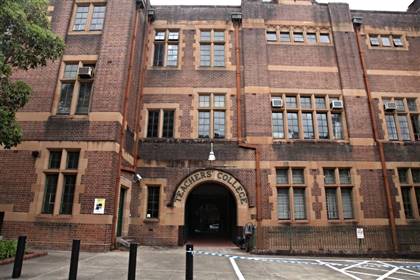Image Shutterstock
On 29 May, the University of Sydney released its Final Change Plan (FCP) for Sydney College of the Arts (SCA).
It has taken into account feedback received in the wake of a Draft Plan released August last year, and almost a year of consultation (August 2016 – May 2017).
The new model sees the School become part of the Faculty of Arts and Social Sciences (FASS), and its relocation into the Old Teachers College (OTC), a shared building located on the Camperdown/Darlington campus.
Author of the report, Professor Stephen Garton, Provost and Deputy Vice-Chancellor, said that the University was mindful of concerns over a ‘diluted identity’ and as a consequence SCA will retain its current name and brand.
The FCP explained the model would provide greater integration for SCA students with the University’s broader educational strategy.
‘There is also a financial imperative to deliver a model that is financially sustainable,’ said Garton, adding that ‘falling enrolments’ had added to the financial burden.
The expected implication of the change is to achieve a reduction in the current operating margin deficit from $5.1 million to approximately $1 million per annum.
The FCPs stated objective is:
a) Increased interdisciplinary collaboration between its staff and other areas in the University, demonstrated by an increase in co-developed curriculum and interdisciplinary research projects;
b) An increase of at least 5% students across the University taking visual arts electives; and
c) Achievement of a sustainable cohort mix of coursework and HDR (Higher Degree Research) students that regularly meets budgeted load.
The big impact outcomes of the FCP on the SCA, as it has been known, will be a reduced studio footprint; reduced student intakes; and reduced staff.
The future structure of SCA
As a department in FASS, SCA sits within the broader School of Literature, Art and Media (SLAM). The report states that there are academic and administrative advantages to adopting this structure – overheads will be reallocated at the school level and a larger school-based structure will allow more resources to be directed to teaching and research requirements.
Second, the location in SLAM and colocation together with the Departments of Art History and Media and Communications and the Digital Cultures and Film Studies programs will maximise the opportunity for collaboration and for the generation of exciting educational outcomes more broadly.
Garton said: ‘We acknowledge the concerns some staff have expressed regarding the adequacy of the space earmarked for SCA in the proposed relocation. However, achieving a reduction of physical footprint is fundamental to ensuring SCA’s financial sustainability.’
The University will embark upon a tender process for the engagement of design firm in June, with construction commencing in December 2017. It is envisaged that phased occupation and testing of the space will occur in January 2019, with the project completed in March 2019 ready for new enrolments.

The Old Teachers College, University of Sydney
Will courses be affected?
In August 2017, a curriculum working group will be convened to draft a curriculum proposal for faculty approval in September, and Academic Board submission in October.
Garton explained: ‘It was initially proposed that the more resource-intensive mediums, including the jewellery and object major and ceramics and glassmaking components of the sculpture major, would be withdrawn from offer for commencing students from 2018.
‘In light of extensive feedback on this proposal and consideration of other options for reducing SCA’s deficit, the University has revised this proposal and now plans to retain some facilities for all current mediums at the new location.’
But he added that the decision to retain ceramics, glass and jewellery within the sculpture and object grouping is contingent upon a revised model for delivery and curriculum approach of these mediums.
He also acknowledged their reduced physical footprint, and specialised and technical staff.
Feedback on the draft plan made clear the need for a dedicated theoretical curriculum, however, Garton reported that while visual arts programs will continue to have dedicated curriculum, the development and delivery of that curriculum should draw upon the staff in the Department of Art History.
Key points summarised
- Sydney College of the Arts (SCA) will become a department within the School of Literature, Art & Media (SLAM) in the Faculty of Arts and Social Sciences (FASS) as of June 2017.
- The Sydney College of the Arts (SCA) identity will be maintained.
- The expected financial impact of the plan is to reduce the operating deficit from $5.1 million to $1 million per annum.
- SCA will be located in the Old Teachers College on Camperdown campus.
- The final design of SCA facilities in the Old Teachers’ College (OTC) will be determined during a period of staff consultation; the tender process for a design firm commences June 2017.
- The OTC fit-out project will take place from December 2017-2018 – there will be a staff consultation process on design. The ground floor of the Badham building will be repurposed to be used for visual arts facilities.
- The future SCA student cohort is anticipated to be between 360-425 students with a greater focus on undergraduate and postgraduate coursework. This is a reduction from around 600-700 students.
- The number of staff is approximately 30, which includes around 29 full-time equivalent (FTE) positions in SCA and an additional role in the Department of Art History. The FTE positions in SCA breaks down to approximately 18 academic roles, nine technical roles and three professional services roles.
- Where positions have been impacted by change, Staff members may submit an expression of interest (EOI) for any unfilled positions in the new structure. This applies to both continuing and fixed-term staff. This process commences in June.
- It is likely that any staff member who has not taken up an offer of VR or secured a role through the EOI process will be issued a notice of redundancy on or about Monday, 25 September 2017.
- The 2018 teaching requirements will be comparable with the projected student cohort size, therefore it is expected that the redundancies will take effect on Friday, 22 December 2017
- There will be a phased move of SCA students from Rozelle to the OTC in Camperdown from January 2019 with the relocation complete by March 2019.
- Work to review the curriculum for 2019 will commence in August 2017.
- Applications for students will re-open in 2018.
- Bachelor of Visual Arts units of study for 2018 will be finalised in consultation with FASS by the end of June 2017. There will be no changes to the program of study for currently enrolled students. It is expected the majority of current students will be taught at Rozelle although some will need to finish their studies in Camperdown.
- The Provost can commission a comprehensive post-implementation review of SCA within two years of the start of 2021, at the request of the Chair of Department and Director, SCA.
- It is proposed that the elected SCA student representatives have regular (minimum 1 per month) meetings with the Chair of Department and Director (SCA) to provide a conduit between the students and management to ensure students are kept informed and engaged through the implementation process.





